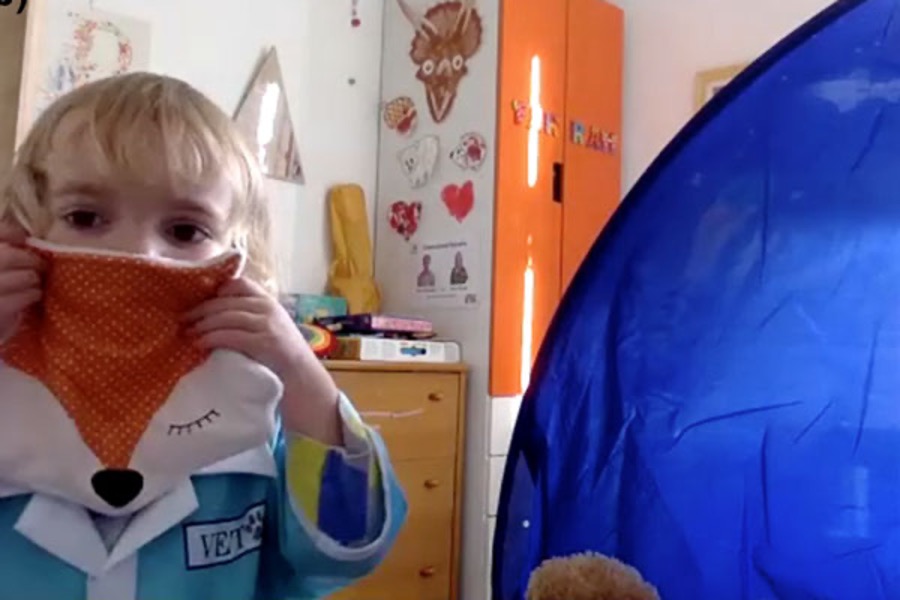Please note that the real names of participants have been changed in this article to protect their privacy.
Embracing children’s perspectives can enrich our understanding of how they are impacted by government policies and the world around them. This is illustrated in a new piece of research on the impact of COVID-19 lockdowns on play from PEDAL PhD student Kelsey Graber.
By interviewing children themselves about their play experiences during the pandemic, this study found that they displayed a resilient capacity to continue playing – even when their options to do so became more limited due to stringent stay-at-home regulations. Children largely expressed positivity, confidence and optimism about playing, even when they could not see friends or play outside as normal. Without disputing the consensus that COVID-19 impeded children’s healthy development, this research suggests that play itself was “not on lockdown”.
Kelsey’s research also demonstrates the protective power of play, as she explains: “While the pandemic certainly adversely affected children, play didn’t just stop. In fact, in many cases, play remained one of the most persistent features of their lives during so much change. It was one way that children could still be children amid all this adversity.”
This study showed that children’s reflections on their experiences were sometimes different to those articulated by adults. Therefore, it highlights that actively listening to and integrating children’s perspectives could make a positive difference to future crisis planning, by helping adults to understand how children will experience change and how to protect what matters to them:
“Children’s perspectives do not need to supersede adult judgements made for their benefit in moments of crisis, but when it comes to something so elemental to childhood as play, their input is essential,” Kelsey adds. “We also need a more balanced public narrative about their experiences during the pandemic, especially as we continue to support their ongoing recovery and plan for the future.”
To capture children’s perspectives, Kelsey ran playful, Zoom-based interviews with the 15 participants, incorporating activities like show-and-tell with toys and games, drawing, writing, and storytelling. She also noted multiple instances of spontaneous play during these interviews, which supports existing research that points to play being a persistent and ubiquitous feature of childhood, even in adverse conditions. “You can’t just not play…because it is play,” Liam, aged nine, explained. Similarly, when asked about what she did while stuck at home, five-year-old Ginny replied simply, “Well…I…sort of played a lot.”
Play was also central to children’s communication and comprehension of their experiences during the pandemic, the study found. For example, Olivia, aged three, decided to play vet with stuffed animals during her interview and showed how she was “keeping germs away” from them by imitating the use of a face mask. This was a poignant example of a very young child showing, through play, that she had grasped something different about the wider circumstances she was caught up in, and of what it meant to be safe and healthy.

Olivia, aged three, showed how she was keeping her stuffed animals safe using a makeshift face mask during a Zoom interview for the study.
Some of the children in the study did express frustration about not being able to go to playgrounds or see friends, and occasional signs of pandemic-related lethargy also surfaced. Ellery, aged 10, referred to her dwindling interest in creative writing, explaining: “So many things have been happening and I’m not really in the mood for it every time.”
These sentiments were, however, less common than expected. Lockdown rarely figured in many of the conversations about play. When asked about how they were staying safe while playing, for instance, children did not reference COVID-19 regulations. Instead, they tended to offer more general safety advice about not running indoors or avoiding broken glass in the park.
As Kelsey emphasises: “In general, children focused on what was possible and what they were achieving through their play – not what was missing.”
This study helps to demonstrate the value of greater recognition and inclusion of children’s voices when considering how significant national events or policy decisions affect them. Children can help us to understand how these decisions shape their childhood, and therefore could play an important role in preparing for future pandemics or other unexpected crises.
Click here to find out more about Kelsey’s work as part of our Play in Health team.

Journal Article
Click here to read the full journal article, via the National Children’s Bureau journal Children & Society.

Further Reading
Find out more about the power of play in times of crisis with the following resources:
- M: Masked play is still play! (Graber, 2021)
- The importance of playing during a crisis (International Play Association, 2020)
- The Importance of Play during Hospitalization of Children (Koukourikos et al., 2015)
- Play as a resource for children facing adversity: An exploration of indicative case studies (Fearn & Howard, 2012)
